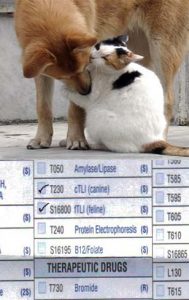Ron Hines DVM PhD
Your Dog Or Cat’s Trypsin-like Immunoreactivity Results
A somewhat different but mostly duplicate article can be found here
The TLI test measures the amounts of a digestive enzymes (trypsin and trypsinogen) in your dog or cat’s blood stream. Those compounds, along with amylase, lipase and chymotrypsinogen are formed in your pet’s pancreas and normally find their way into its intestine through the pancreatic duct that connects the two organs.
A small amount of these compounds normally slip into your pet’s blood stream. Measuring that amount is a good way for your veterinarian to check out your dog or cat’s pancreatic function.
Some laboratories believe that the TLI test is the most accurate way to detect dogs and cats whose pancreases are not producing sufficient trypsinogen/trypsin (=exocrine pancreatic insufficiency = EPI). Conversely, in dogs that have higher than normal TLI test results, the pet is believed to probably be experiencing acute pancreatitis.
There are many tests that can help your vet diagnose pancreatic problems and diagnostic laboratories always think that the ones they perform and market are the best. Read about the alternative PLI and cPL® or fPL® (PLI), lipase and amylase, tests by clicking those links. The reason there are so many in use is that none of them detect pancreatic problems as reliably as we veterinarians might wish they did.
Reasons Why Your Dog’s TLI Levels Could Be High:
High TLI levels are often present in dogs experiencing pancreatitis. However, that is not always the case. Some dogs with Pancreatitis have normal TLI levels. That may be due to the short period of time that this particular enzymes remain present in the blood stream after it is released.
TLI levels can also occasionally go up when chronic kidney disease or malnutrition are present.
High TLI levels do not consistently occur in cats that have acute pancreatitis. So for them, the test is only helpful in the chronic pancreatic conditions that limit the amount of trypsin produced (exocrine pancreatic insufficiency or EPI).
Reasons Why Your Dog or Cat Could Have A Low TLI Level:
Both dogs and cats that have chronic pancreatic problems that have affected the amount of digestive enzymes the organ produces (exocrine pancreatic insufficiency /EPI) can be expected to have low TLI levels.
Things like cholangiohepatitis / triad disease in cats are common causes of EPI. Dogs with pancreatic acinar atrophy (PAA), a type of autoimmune disease, also have low TLI levels. Breeds known to be affected include German shepherds, collies, and eurasiers. (read here)
Complementary Tests:
The other pancreatic tests mentioned at the beginning of this article, CBC/ WBC and blood chemistry values including blood calcium level (mildly low in many cases of acute pancreatitis), urinalysis, review of diet ingredients, abdominal x-rays, ultrasound exam, perhaps a pancreatic biopsy
DxMe
